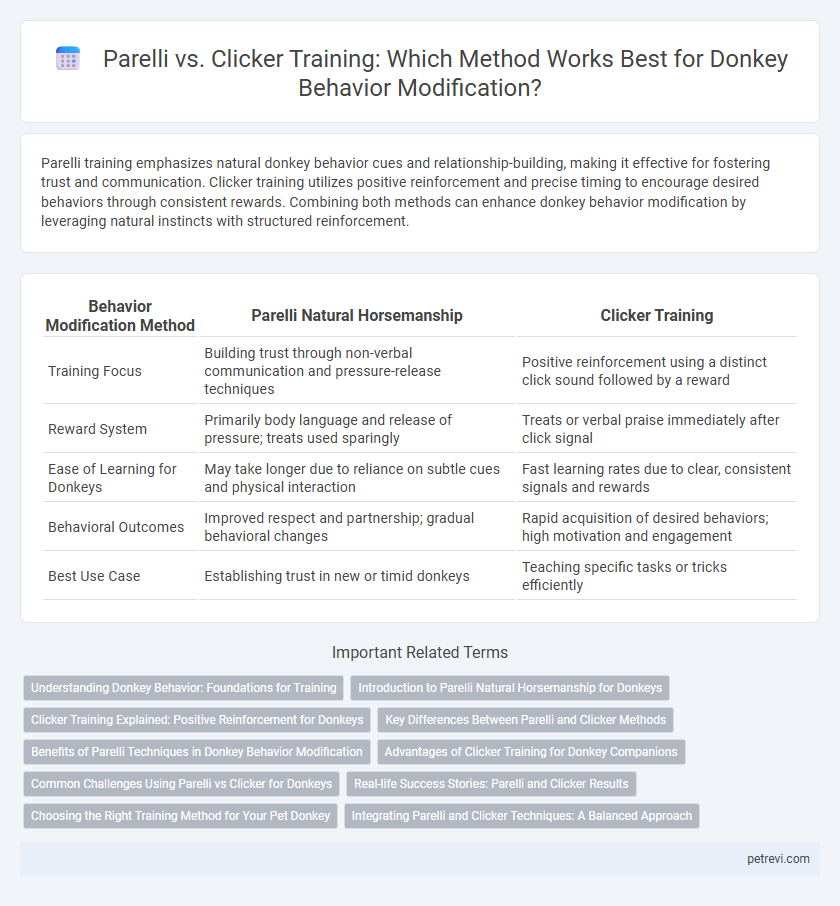Parelli training emphasizes natural donkey behavior cues and relationship-building, making it effective for fostering trust and communication. Clicker training utilizes positive reinforcement and precise timing to encourage desired behaviors through consistent rewards. Combining both methods can enhance donkey behavior modification by leveraging natural instincts with structured reinforcement.
Table of Comparison
| Behavior Modification Method | Parelli Natural Horsemanship | Clicker Training |
|---|---|---|
| Training Focus | Building trust through non-verbal communication and pressure-release techniques | Positive reinforcement using a distinct click sound followed by a reward |
| Reward System | Primarily body language and release of pressure; treats used sparingly | Treats or verbal praise immediately after click signal |
| Ease of Learning for Donkeys | May take longer due to reliance on subtle cues and physical interaction | Fast learning rates due to clear, consistent signals and rewards |
| Behavioral Outcomes | Improved respect and partnership; gradual behavioral changes | Rapid acquisition of desired behaviors; high motivation and engagement |
| Best Use Case | Establishing trust in new or timid donkeys | Teaching specific tasks or tricks efficiently |
Understanding Donkey Behavior: Foundations for Training
Donkey behavior is rooted in social intelligence, cautiousness, and sensitivity to environmental stimuli, which makes training approaches like Parelli and Clicker more effective when aligned with these traits. Parelli emphasizes building a partnership through body language and natural horsemanship techniques, leveraging donkeys' instinctive communication cues. Clicker training uses positive reinforcement by marking desired behaviors with an audible click, catering to donkeys' learning through consistent and clear signals, crucial for modifying behavior efficiently.
Introduction to Parelli Natural Horsemanship for Donkeys
Parelli Natural Horsemanship for donkeys emphasizes understanding their natural instincts and communication to build trust and cooperation. This method uses guided exercises and subtle body language cues to promote positive behavior without force or punishment. Incorporating Parelli's techniques can improve donkey responsiveness and strengthen the handler-animal bond effectively.
Clicker Training Explained: Positive Reinforcement for Donkeys
Clicker training is a highly effective positive reinforcement method for donkey behavior modification, utilizing a distinct clicking sound to mark desired actions. This technique helps donkeys associate the click with a reward, encouraging repetition of good behavior and accelerating learning. Compared to Parelli methods, clicker training offers precise communication and consistency, essential for building trust and cooperation in donkeys.
Key Differences Between Parelli and Clicker Methods
Parelli and Clicker training differ primarily in their approach to donkey behavior modification; Parelli uses a natural horsemanship technique emphasizing body language and pressure-release signals, while Clicker training relies on operant conditioning with a distinct sound marker to reinforce desired behaviors. Parelli fosters a relationship built on subtle cues and communication, whereas Clicker training provides clear, immediate feedback through the clicking sound paired with treats. Each method varies in timing, communication style, and reinforcement strategies, influencing how donkeys learn and respond to commands.
Benefits of Parelli Techniques in Donkey Behavior Modification
Parelli techniques emphasize natural donkey behavior understanding and communication through body language, fostering trust and reducing stress during training. This method encourages leadership and partnership, leading to long-term behavioral improvements and enhanced donkey responsiveness. The focus on holistic interaction supports emotional well-being and promotes gentle, consistent behavioral adjustments.
Advantages of Clicker Training for Donkey Companions
Clicker training offers precise, clear communication by using a consistent sound marker that donkeys quickly associate with positive reinforcement, enhancing learning speed and motivation. This method encourages voluntary participation and reduces stress by avoiding negative pressure, fostering a stronger bond between donkey and handler. Its adaptability suits various behaviors, making it effective for shaping complex donkey actions with patience and consistency.
Common Challenges Using Parelli vs Clicker for Donkeys
Donkeys often present unique behavioral challenges such as stubbornness and slow response to training stimuli, which can affect the efficiency of Parelli versus clicker methods. Parelli's natural horsemanship techniques may struggle with donkeys' independent nature due to reliance on body language and pressure-release cues, while clicker training provides clear, consistent positive reinforcement that aligns better with donkeys' cognitive abilities. Common challenges include slower progress and difficulty in establishing communication cues when using Parelli, whereas clicker training often yields more precise and measurable improvements in donkey behavior modification.
Real-life Success Stories: Parelli and Clicker Results
Parelli Natural Horsemanship and Clicker Training both demonstrate effective behavior modification in donkeys, with numerous real-life success stories highlighting improved trust and responsiveness. Parelli's holistic approach emphasizes body language and emotional connection, resulting in donkeys that exhibit reduced aggression and increased cooperation in farm settings. Clicker Training, using positive reinforcement through sound cues, consistently yields quicker learning and problem-solving behaviors, especially in rescue donkeys adapting to new environments.
Choosing the Right Training Method for Your Pet Donkey
Choosing the right training method for your pet donkey involves understanding the differences between Parelli Natural Horsemanship and clicker training. Parelli focuses on pressure and release techniques rooted in natural herd behavior, while clicker training uses positive reinforcement to mark desired behaviors instantly. Selecting the best approach depends on your donkey's temperament, learning pace, and your consistency in applying either method for effective behavior modification.
Integrating Parelli and Clicker Techniques: A Balanced Approach
Integrating Parelli and clicker training techniques offers a balanced approach to donkey behavior modification by combining natural horsemanship principles with precise operant conditioning methods. Parelli emphasizes relationship-building and energy communication, while clicker training provides clear, consistent markers for desired behaviors, enhancing learning speed and accuracy. This synergy improves donkey responsiveness and cooperation, leading to more effective and humane training outcomes.
Parelli vs Clicker for Donkey Behavior Modification Infographic

 petrevi.com
petrevi.com